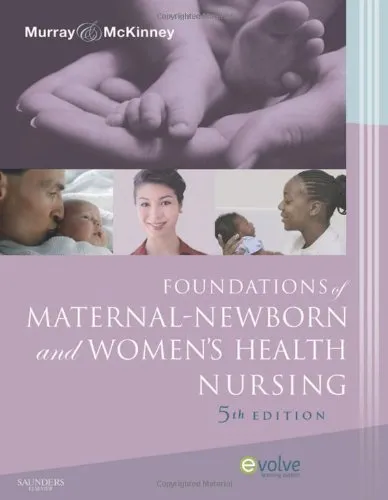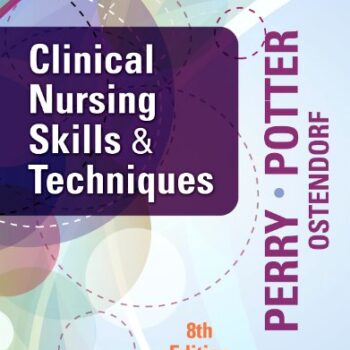Foundations of Maternal-Newborn and Women’s Health Nursing 5th Edition Test Bank
$55.00 Original price was: $55.00.$24.00Current price is: $24.00.
Digital item No Waiting Time Instant Download
Chapters: 27
Format: PDF
ISBN-13: 978-0323398947
ISBN-10: 9780323398947
Publisher: Saunders
Authors: Sharon Smith Murray, Emily Slone McKinney
Description
Foundations of Maternal-Newborn and Women’s Health Nursing 5th Edition Test Bank
Table of Contents
PART I: FOUNDATIONS FOR NURSING CARE OF THE CHILDBEARING FAMILIES
1. Maternity and Women’s Health Care Today
2. Social, Ethical and Legal Issues
3. Reproductive Anatomy and Physiology
4. Hereditary and Environmental Influences on Childbearing
PART II: THE FAMILY BEFORE BIRTH
5. Conception and Prenatal Development
6. Maternal Adaptations to Pregnancy
7. Antepartum Assessment, Care and Education
8. Nutrition for Childbearing
9. Assessing the Fetus
10. Complications of Pregnancy
11. The Childbearing Family with Special Needs
PART III: THE FAMILY DURING BIRTH
12. Processes of Birth
13. Pain management during Childbirth
14. Intrapartum Fetal Surveillance
15. Nursing Care During Labor and Birth
16. Intrapartum Complications
PART IV: THE FAMILY FOLLOWING BIRTH
17. Postpartum Adaptations and Nursing Care
18. Postpartum Maternal Complications
19. Normal Newborn: Processes of Adaptation
20. Assessment of the Normal Newborn
21. Care of the Normal Newborn
22. Infant Feeding
23. High-Risk Newborn: Complications Associated with Gestational Age and Development
24. High-Risk Newborn: Acquired and Congenital Conditions
PART VI: WOMEN’S HEALTH CARE
25. Family Planning
26. Infertility
27. Women’s Health Care
Appendixes
A. Use of Drugs and Botanical Preparations during Pregnancy and Breastfeeding
B. Answers to Knowledge Check
C. Answers to Critical Thinking Exercises
Chapter 01: Foundations of Maternity, Women’s Health, and Child Health Nursing
McKinney: Evolve Resources for Maternal-Child Nursing, 5th Edition
MULTIPLE CHOICE
1. Which factor significantly contributed to the shift from home births to hospital births in the
early 20th century?
a. Puerperal sepsis was identified as a risk factor in labor and delivery.
b. Forceps were developed to facilitate difficult births.
c. The importance of early parental-infant contact was identified.
d. Technologic developments became available to physicians.
ANS: D
Technologic developments were available to physicians, not lay midwives. So in-hospital
births increased in order to take advantage of these advancements. Puerperal sepsis has been a
known problem for generations. In the late 19th century, Semmelweis discovered how it could
be prevented with improved hygienic practices. The development of forceps is an example of
a technology advance made in the early 20th century but is not the only reason birthplaces
moved. Unlike home births, early hospital births hindered bonding between parents and their
infants.
PTS: 1 DIF: Cognitive Level: Knowledge/Remembering
REF: p. 1 OBJ: Integrated Process: Teaching-Learning
MSC: Client Needs: Safe and Effective Care Environment
2. Family-centered maternity care developed in response to
a. demands by physicians for family involvement in childbirth.
b. the Sheppard-Towner Act of 1921.
c. parental requests that infants be allowed to remain with them rather than in a
nursery.
d. changes in pharmacologic management of labor.
ANS: C
As research began to identify the benefits of early extended parent-infant contact, parents
began to insist that the infant remain with them. This gradually developed into the practice of
rooming-in and finally to family-centered maternity care. Family-centered care was a request
by parents, not physicians. The Sheppard-Towner Act of 1921 provided funds for
state-managed programs for mothers and children. The changes in pharmacologic
management of labor were not a factor in family-centered maternity care.
PTS: 1 DIF: Cognitive Level: Knowledge/Remembering
REF: p. 2 OBJ: Integrated Process: Teaching-Learning
MSC: Client Needs: Psychosocial Integrity
3. Which setting for childbirth allows the least amount of parent-infant contact?
a. Labor/delivery/recovery/postpartum room
b. Birth center
c. Traditional hospital birth
d. Home birth
ANS: C
In the traditional hospital setting, the mother may see the infant for only short feeding periods,
and the infant is cared for in a separate nursery. The labor/delivery/recovery/postpartum room
setting allows increased parent-infant contact. Birth centers are set up to allow an increase in
parent-infant contact. Home births allow an increase in parent-infant contact.
PTS: 1 DIF: Cognitive Level: Knowledge/Remembering
REF: p. 2 OBJ: Nursing Process: Planning
MSC: Client Needs: Health Promotion and Maintenance
4. As a result of changes in health care delivery and funding, a current trend seen in the pediatric
setting is
a. increased hospitalization of children.
b. decreased number of children living in poverty.
c. an increase in ambulatory care.
d. decreased use of managed care.
ANS: C
One effect of managed care has been that pediatric health care delivery has shifted
dramatically from the acute care setting to the ambulatory setting in order to provide more
cost-efficient care. The number of hospital beds being used has decreased as more care is
given in outpatient settings and in the home. The number of children living in poverty has
increased over the past decade. One of the biggest changes in health care has been the growth
of managed care.
PTS: 1 DIF: Cognitive Level: Knowledge/Remembering
REF: p. 5 OBJ: Nursing Process: Planning
MSC: Client Needs: Safe and Effective Care Environment
5. The Women, Infants, and Children (WIC) program provides
a. well-child examinations for infants and children living at the poverty level.
b. immunizations for high-risk infants and children.
c. screening for infants with developmental disorders.
d. supplemental food supplies to low-income pregnant or breastfeeding women.
ANS: D
WIC is a federal program that provides supplemental food supplies to low-income women
who are pregnant or breastfeeding and to their children until age 5 years. Medicaid’s Early
and Periodic Screening, Diagnosis, and Treatment Program provides for well-child
examinations and for treatment of any medical problems diagnosed during such checkups.
Children in the WIC program are often referred for immunizations, but that is not the primary
focus of the program. Public Law 99-457 is part of the Individuals with Disabilities Education
Act that provides financial incentives to states to establish comprehensive early intervention
services for infants and toddlers with, or at risk for, developmental disabilities.
PTS: 1 DIF: Cognitive Level: Comprehension REF: p. 8
OBJ: Integrated Process: Teaching-Learning
MSC: Client Needs: Health Promotion and Maintenance
6. In most states, adolescents who are not emancipated minors must have the permission of their
parents before
a. treatment for drug abuse.
b. treatment for sexually transmitted diseases (STDs).
c. accessing birth control.
d. surgery.
ANS: D
Minors are not considered capable of giving informed consent, so a surgical procedure would
require consent of the parent or guardian. Exceptions exist for obtaining treatment for drug
abuse or STDs or for getting birth control in most states.
PTS: 1 DIF: Cognitive Level: Knowledge/Remembering
REF: p. 17 OBJ: Nursing Process: Planning
MSC: Client Needs: Safe and Effective Care Environment
7. The maternity nurse should have a clear understanding of the correct use of a clinical
pathway. One characteristic of clinical pathways is that they
a. are developed and implemented by nurses.
b. are used primarily in the pediatric setting.
c. set specific time lines for sequencing interventions.
d. are part of the nursing process.
ANS: C
Clinical pathways are standardized, interdisciplinary plans of care devised for patients with a
particular health problem. They are used to identify patient outcomes, specify time lines to
achieve those outcomes, direct appropriate interventions and sequencing of interventions,
include interventions from a variety of disciplines, promote collaboration, and involve a
comprehensive approach to care. They are developed by multiple health care professionals
and reflect interdisciplinary care. They can be used in multiple settings and for patients
throughout the life span. They are not part of the nursing process but can be used in
conjunction with the nursing process to provide care to patients.
PTS: 1 DIF: Cognitive Level: Knowledge/Remembering
REF: p. 7 OBJ: Nursing Process: Planning
MSC: Client Needs: Safe and Effective Care Environment
8. The fastest growing group of homeless people is
a. men and women preparing for retirement.
b. migrant workers.
c. single women and their children.
d. intravenous (IV) substance abusers.
ANS: C
Pregnancy and birth, especially for a teenager, are important contributing factors for becoming
homeless. People preparing for retirement, migrant workers, and IV substance abusers are not
among the fastest growing groups of homeless people.
PTS: 1 DIF: Cognitive Level: Knowledge/Remembering
REF: p. 14 OBJ: Nursing Process: Assessment
MSC: Client Needs: Physiologic Integrity
9. A nurse wishes to work to reduce infant mortality in the United States. Which activity would
this nurse most likely participate in?





Be the first to review “Foundations of Maternal-Newborn and Women’s Health Nursing 5th Edition Test Bank”